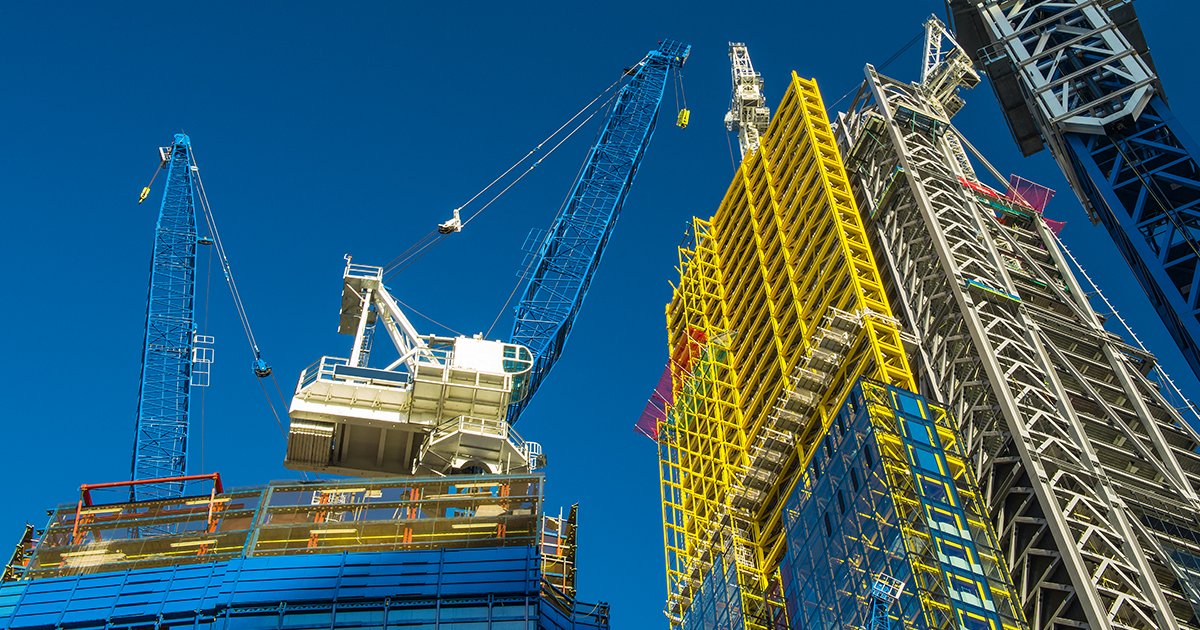War in Ukraine has had a significant human cost, with thousands of lives lost and millions of other people displaced due to the conflict. The country’s-built environment also bears the scars of the conflict and is currently the world’s largest construction site.
Homes, industrial facilities, and major infrastructure have been damaged or destroyed, with the cost of recovery over the longer-term likely to exceed $1 trillion: an international effort – pooling finance, skills, innovative processes and technology – is already underway to help Ukraine build back better.
For Ukraine’s government, its international partners, and global businesses, the reconstruction of Ukraine offers a significant opportunity to not only rebuild the infrastructure of Ukraine but to build back better and to reimagine the way in which infrastructure is designed and delivered to help modernise the Ukrainian economy.
Hear Nigel Blundell discuss this story on The Pinsent Masons podcast here or wherever you get your podcasts.
The scale of destruction and cost of rebuild
A joint assessment by the World Bank, government of Ukraine, EU, UN, and Kyiv School of Economics (KSE) estimates the reconstruction and recovery needs of Ukraine over the next 10 years to be $411 billion – some 2.6 times the size of Ukraine’s GDP in 2022. This assessment accounts for surge pricing and building back better with investments in government-prioritised sectors for 2023 of $14 billion.
The estimate set out in the rapid damage and needs assessment (RDNA2), however, does not include the cost of reconstruction of buildings, facilities and infrastructure damaged or destroyed since the date of assessment on 24 February 2023 – such as the destruction of the Kakhovka dam on the Dnieper river and subsequent downstream flooding.
The eventual cost of reconstruction and building back better in nominal terms for such a colossal undertaking is likely, in our view, to be $1 trillion over many decades.
The quality of Ukraine’s existing infrastructure, as ranked by the World Economic Forum prior to the conflict, was relatively poor, at 57 out of 141 countries. Significant improvement and investment in Ukraine’s infrastructure will be needed to bring it up to the standard of EU countries, with Ukraine’s prospective membership of the trade bloc now seemingly on an accelerated path.
The RDNA2 provides an insight into where the most damage has occurred. Housing, for example, is estimated to have sustained the greatest damage at $50 billion, followed by transport at $36 billion. Damage to energy and extractives infrastructure is estimated at $11 billion.
In total, damage to Ukraine’s infrastructure and physical assets in the first year of the war to 24 February 2023 is estimated to have reached $135 billion and accounts for around 25% currency devaluation. Damage to infrastructure and physical assets is calculated using standard methodology and at 2021 replacement prices.
Total economic, social and other monetary losses are estimated at $290 billion.
According to the RDNA2, the cost of overall reconstruction and recovery will involve $92.1 billion being spent on transport infrastructure, $68.6 billion on housing, and $47 billion on energy and extractives infrastructure over the next 10 years. A total of $37.6 billion has been set aside for explosive hazard management.
The road to recovery
The scale of investment needed for Ukraine’s reconstruction is substantial and will require leveraging public and international donor financing together with a significant amount of private investment. It will also require a considerable mobilisation of engineering design, legal, financial and contracting capability from across the world.
Spending on construction in Ukraine has been recovering in 2023 from historic lows in 2022 but will take time to recover to pre-war levels – those levels had been driven up by spending on construction following Russia’s annexation of Crimea in 2014, with the rate of growth in the three-year period after 2014 particularly high.
The private sector plays a much more significant role in Ukraine’s economy than the public sector, accounting for up to 70% of total output. Private sector investment will therefore be critical to reconstruction. The state has a large involvement in both transport and energy sectors. However, a stronger public-private partnership (PPP) framework is needed to enable much greater private participation in infrastructure. Significant policy intervention is needed to support private financing and to mitigate and cover investment and delivery risk.
There are other significant market and institutional constraints that will make building back better challenging. For example, more than eight million Ukrainians have been displaced across Europe, which means that in the local labour market there is a shortage of the availability of contractors for undertaking repairs and reconstruction. There is also a shortage of available materials and manufacturing capacity. Insurance and guarantees to help protect private sector investment also need to be put in place, while reforms will be necessary to planning processes and local government institutional capacity will need to be strengthened as a priority too.
Notwithstanding the challenges that lie ahead, governments around the world and the international business community are already lining up to help.
For example, US company Bechtel has signed a memorandum of understanding with Ukraine’s State Agency for Restoration and Infrastructure Development on a national program that priorities key infrastructure corridors and AECOM will provide program management and technical advisory support, while the Korea’s Ministry of Land, Infrastructure and Transport (MOLIT), Korail, and Korean National Railway (KNR) signed a memorandum of understanding to help rebuild Ukraine’s railway infrastructure and build a new high speed railway to link Ukraine with Poland
Pinsent Masons met with the Ukrainian State Agency for Restoration and Infrastructure Development and, together with Atkins Realis, Mace and Costain, produced a playbook called Reimagining Ukraine to set out how the UK professional services sector can help Ukraine rebuild its shattered infrastructure and build back better
What building back better in Ukraine might look like
Building back better in Ukraine will be a multi-faceted mega project, in infrastructure and economic terms. It will require a combination of political will, international finance, and the combined expertise of businesses from all around the world.
The size and scale of the task in Ukraine is so large and complex that it requires high-level collaboration. Lessons can be learned from giga projects in Saudi Arabia and large-scale programmes such as the Reconstruction with Changes Programme in Peru, which have shown that it is essential to coordinate programmes of infrastructure and buildings and to set up a program delivery partner organisation that can set the strategy for the procurement and delivery of many thousands of projects.
However, at Pinsent Masons, we consider that there will be a wide range of other critical components to not only restoring Ukraine to what it had pre-conflict, but to helping the country rebuild its built environment and wider economy.
PPP and innovative private financing models
The huge need for private investment will require much greater use of public-private partnerships (PPPs) in key infrastructure sectors – principally transport and energy. This will be particularly relevant if Ukraine is to connect to an extended Trans-European Transport Network (TEN-T) which is a network of roads, railways, airports and water infrastructure in the EU.
Insurance and guarantees
The lack of available insurance is currently a major barrier preventing companies trading with and investing in Ukraine to help it rebuild. For its part, the UK signed a war-risk insurance statement of intent with the European Bank for Reconstruction and Development (EBRD) on 31 October 2023 to help UK companies to do business in Ukraine. The EBRD scheme will provide new support for boosting the provision of insurance against war related risks in Ukraine.
Investors looking to invest in reconstruction in Ukraine will also want to ensure that their investments are protected against political risks. This could include nationalisation, restrictions on capital transfer, government intervention, withdrawal of permits or future changes of policy by the government of Ukraine. Protection against political risk will be important as the state plays a more prominent role in commercial relations in Ukraine than many other Western countries. Sophisticated investors protect their business interests against political risk through bilateral investment treaties (BITs) or multilateral investment treaties. BIT arbitration is a powerful means of holding host nations accountable.
Land use and planning
Land use and planning underpin most physical aspects of an economy. Identifying how Ukraine’s land resources can be better used to support the country's recovery is a fundamental issue affecting development. Consideration must be given to how land has been and is currently owned and occupied in Ukraine.
Understanding ownership under the Soviet system is also important. It wasn’t until the collapse of Soviet Russia that land began to be privatised – up until then all land resources belonged to the state. Thought needs to be given to any remaining legacy issues and to whether there are opportunities for more equitable distribution of land during the reconstruction process.
Procurement and contracting strategies
Procurement and contracting strategies for construction will need to be developed to deal with the need for speed as well as compliance with regulatory frameworks – but most importantly, a significant amount of innovation will be needed, which will need the careful development of contractual frameworks. Procurement processes must meet the highest standards of openness, fairness, and transparency.
Delivery of a complex programme of infrastructure needs high levels of collaborative working and a real understanding of how to manage alliances which need to handle and manage large amounts of innovative work that embraces net zero and the use of modern methods of construction. Project 13 is an example of an approach to collaborative working that has worked in the UK. It relies on an enterprise model where all project parties, including the commissioning client, are a part of the enterprise. This model is supported by NEC multi-party contracts and other collaborative contracting strategies.
Joint ventures
The development and use of joint ventures for major infrastructure programmes – and the structuring of those JVs – will be essential to success in delivery.
Bringing together JVs of the best capability to deliver complex and large-scale infrastructure requires a wide range of key considerations and to ensure that JVs have the best opportunity to perform. Bringing together the best capabilities and enabling technologies requires careful structuring to help ensure success.
Managing risk and disputes
With the size and scale of complex infrastructure, there is high potential for disputes which could delay reconstruction efforts in Ukraine.
The potential for a fast-track alternative dispute resolution and arbitration process to be established to aid reconstruction and accelerate the resolution of any issues that emerge is a vital area to examine and develop ideas.
The use of data and technology, as well as smart risk registers, will help avoid disputes, and the use of independent project boards can also accelerate dispute resolution.
Transparency and compliance
Transparency and compliance will be central to achieving success in the reconstruction of Ukraine. Without it, there is a risk of corruption and an associated risk that investors and best-in-class businesses will elect not to be involved in the project.
It will be important to ensure public and private sector organisations, including from supporting partner countries, develop mature systems of governance as part of fair and transparent procurement processes, and that those involved in the delivery of new infrastructure are subject to transparency laws and other regulation to mitigate the risk of corruption.
Industrialised construction
The use of industrialised construction will be essential to the fast-track delivery of high-quality housing and infrastructure.
A number of countries, such as the UK, Singapore, Hong Kong, and Australia, are already world leaders in the use of modern methods of construction and advanced industrialised construction – and in deploying contractual frameworks that support industrialised construction and make modern methods of construction work.
The use of mass industrialised construction also provides the opportunity to decarbonise and to make a step change in productivity.
Building safety
Contractors from all over the world are likely to be involved in delivering new buildings and infrastructure in Ukraine – bringing with them different approaches to and cultures on building safety.
Importing world class building safety standards into Ukrainian projects can help ensure a uniform approach to reconstruction, which delivers not only safety for workers but also completed assets that are safe to occupy, operate and maintain in the long-term.
Endorsing best practice towards building safety can also be an enabler for other core objectives of reconstruction in Ukraine – including decarbonisation.
Climate change
There is a need to design lower carbon new infrastructure and design, construct, and adapt existing infrastructure to become more resilient to the effects of climate change.
Using an industrialised approach to design and construction, and adopting a regime that promotes building safety, will vastly improve the carbon footprint of Ukraine’s infrastructure – and help modernise Ukraine’s economy at the same time.
Rebuilding industrial production and supply chains
Rebuilding Ukraine’s industrial production capacity, as well as the supply chains and logistics that serve the manufacturing sector, is also of paramount importance.
This is especially important because Ukraine has a large industrial base that manufactures a significant amount of building materials which will be needed in the rebuilding of infrastructure and housing.
Shortened lead times in getting manufacturing facilities established and reimagining an industrialised approach to the production of components and factory-made houses, will be critical.
Agriculture, food and drugs, and associated supply chains
Both the agricultural industry in Ukraine and the pharmaceutical sector support a large workforce and make significant contributions to Ukraine’s exports.
Helping those industries recover will help provide more immediate incomes for Ukraine’s economy to start to become self-sufficient.


